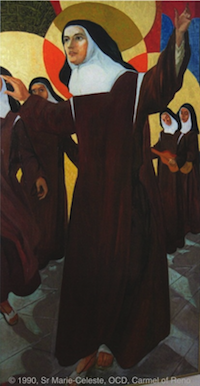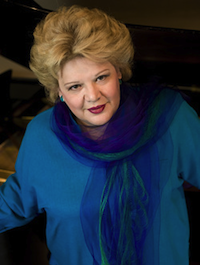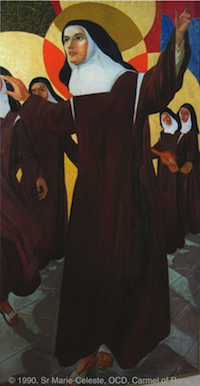
The life of Saint Teresa of Avila followed an improbable trajectory; born into a family of converted Spanish Jews, she embraced Christianity and later co-founded the Discalced Carmelite Order, established 17 of its monasteries, and was selected as the first woman Doctor of the Church. She was canonized 40 years after her death, and her devotional messages are still admired today. One doesn’t have to be an adherent of Roman Catholicism to admire a life of such extraordinary devotion and practical accomplishment, or to recognize her interfaith acumen as prototype for a kind of faith-based feminism.
To celebrate St. Teresa’s spiritual creativity as the 500th anniversary of her birth approaches next year, the Discalced Carmelite Family of the Western U.S. presented an impressive concert at the Cathedral Basilica of Saint Joseph on Friday in San José. Though the Carmelite Order is known for solitary devotions and mystical contemplations, the musical fare on this occasion emphasized joyous public celebration in a mix of classical works, those of contemporary Catholic composers, and a premiere a new composition by celebrated operatic mezzo-soprano, Dolora Zajick. The sudden emergence of a worldly singer as a sacred composer aroused my interest.
It turns out that Zajick’s devotion to the Carmelite Order is no fluke. When not touring as a singer, the mezzo spends much of her home time in Reno at a nearby Carmelite Monastery, her commitment to it a life-long passion. Zajick’s new Roads to Zion is an opera scene for solo voice (Zajick), female chorus, and small orchestra. It depicts St. Teresa encouraging novitiate nuns on various stages of their spiritual journeys to reach God’s dwelling place. The text, derived from Psalm 84, describes that journey in three parts: the soul’s yearning, its taking flight, and its returning. The outer parts contain the solo-choral dialogues; the middle one is purely instrumental.
The work’s distinct Arabic-sounding musical scale, the building block from which the rest of it springs, derives from modifying, by half steps up, both the third and the seventh notes of the Phrygian church mode. Characteristic also of Sephardic Jewish music of the era, the modified mode is still encountered today in some parts of Spain. (It bears mentioning, somewhat wistfully, that Jews and Arabs interacted and thrived together at an even earlier time in Spain’s history.)
Though Roads to Zion is Zajick’s first public composition, it demonstrates accomplished vocal and instrumental writing, with evocative motifs in its unusual modality. At first they resemble the antique contours one may hear in movie scores set in the ancient Middle East. As the work unfolds, however, Zajick’s kernel motif (E, F, D sharp, G sharp) goes further than most movie scores even attempt in the exploration of close modulations, frisson-inducing dissonances, bell-like tones that invoke church rituals, and even, in the work’s third part, a flirtation with bitonality.
Zajick's performance of Roads to Zion was on a high professional level. Conveyed within the generous acoustics of the cruciform baroque cathedral — one of the most impressive in the USA — it delivered its message in a resonant, almost beatific, glow.
The performance of Roads to Zion was on a high professional level. Conveyed within the generous acoustics of the cruciform baroque cathedral — one of the most impressive in the USA — it delivered its message in a resonant, almost beatific, glow. Zajick’s mezzo is a wonder on any opera stage, but as a dramatic mezzo-soprano she typically sings troubled characters with dark colorings; think of Azucena in Il trovatore and Amneris in Aida. At the Met Opera’s production of Dvorák’s Rusalka earlier this year, she portrayed the Water-Goblin Ježibaba. On this occasion, however, her St. Teresa allowed the sweetest regions of her voice to soar in bright, fresh raptures. A vocal instrument of such power and beauty was a rare treat as it filled the cathedral’s vast chambers. The appreciative audience knew it.
A second performance of Roads to Zion is already planned for Madrid for next spring, coinciding closer to the actual birthdate of St. Teresa of Avila. In conversation with Zajick at a reception after the performance, she informed me of her intention to augment the music of this scene with additional material to complete a one-act opera. I asked her if she would like to see it performed with Francis Poulenc’s one-act Dialogue of the Carmelites, and she indicated she would be pleased if it were.

Other works on the program, in a cappella or with instrumental complements, included three compositions from the talented Claire Sokol, OCD, whose Virgin of the Solitude, Living Water, and Nada Te Turbe (“Let Nothing Disturb You”) were sung by the Teresian Singers (a female ensemble of nuns and secular adherents) and the Orchestra of St. James Cathedral under the direction of James Savage. Sokol’s style might be called contemporary religious romanticism, with frequent use of suspended 6ths and 9ths as expressive devices. In a similar mode was Mothering God by Laureen Grady, OCD, and a contemporary arrangement of the 13th-century Christo Psallat Ecclesia/Psalm 47. Overall these pieces struck me as analogous, in musical terms, to the paintings of the Nazarene Movement’s aesthetic-inspired Catholicism in early 19th-century Vienna and Rome.
Instrumental selections from familiar classical works included the “Procession” from Benjamin Britten’s A Ceremony of Carols, the “Siciliana” from Carlos Salzedo’s Suite of Eight Dances, the “Preludium” from Edvard Grieg’s Holberg Suite, “Nimrod” from Edward Elgar’s Enigma Variations, and the Allegro Moderato from J. S. Bach’s Brandenburg Concerto No. 3.
Zajick also sang a tender-voiced rendition of Hugo Wolf’s Verborgenheit (translated on this program as “Solitude”) a setting of the haunting poem of Eduard Mörike that asks the world to leave a grieving heart alone. Joseph Adam was her sensitive piano accompanist.

